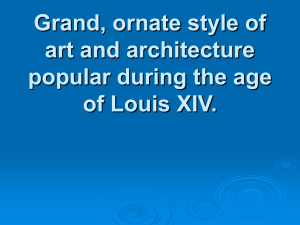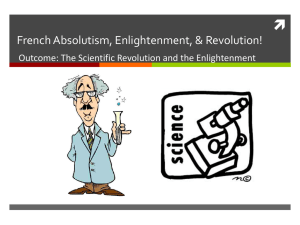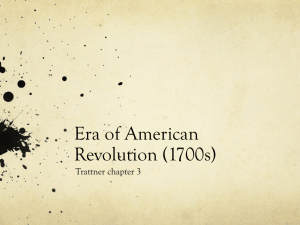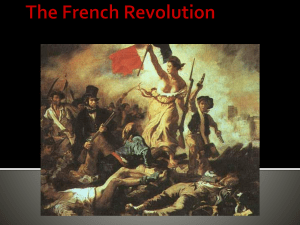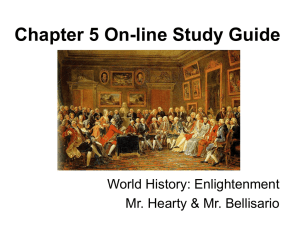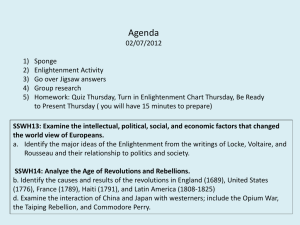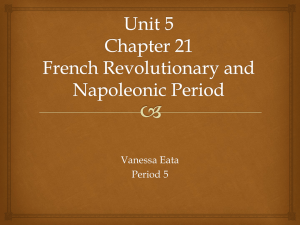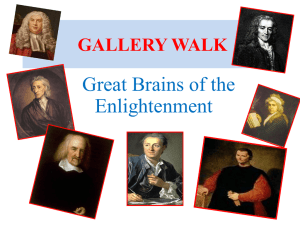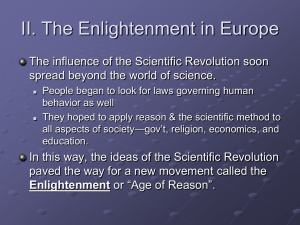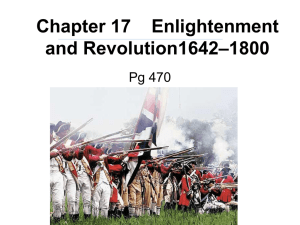REVIEW FOR THE UNIT 8 TEST
advertisement
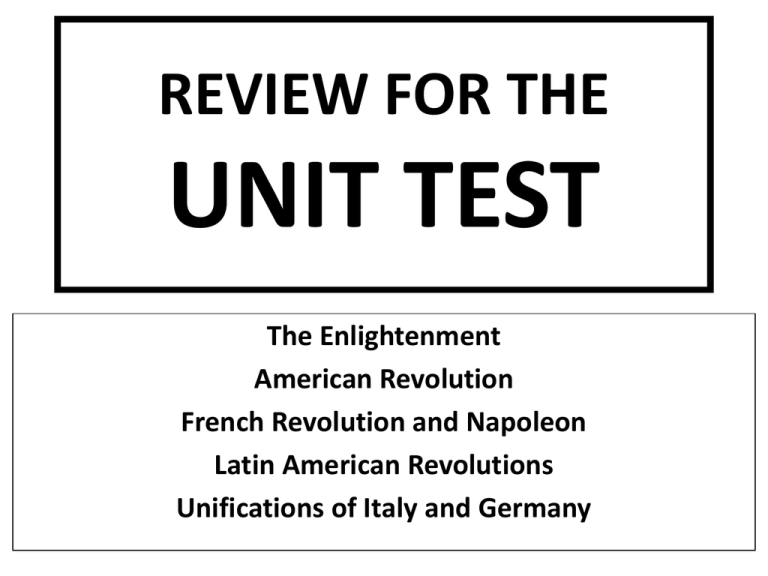
REVIEW FOR THE UNIT TEST The Enlightenment American Revolution French Revolution and Napoleon Latin American Revolutions Unifications of Italy and Germany The two eras known as the Renaissance and the Enlightenment are similar in that they both led to people doing two things: (1) Question the world around them (2) try to improve society During the Scientific Revolution, scholars applied logic and reason; this inspired the Enlightenment thinkers to also use logic and reason as they came up with new ideas about economics and government Political Ideas of the Enlightenment Baron de Montesquieu felt that too much power in the hands of one person always leads to tyranny; Rousseau agreed with this idea of too much power Montesquieu believed in separation of powers: dividing power among three branches of government Political Ideas of the Enlightenment The Swiss philosophe Jean-Jacques Rousseau believed in individual freedom Rousseau believed that people are naturally good, but too much power corrupts them Political Ideas of the Enlightenment John Locke said that the purpose of government was to protect citizens’ natural rights Locke believed that people are born with natural rights: rights to life, liberty, and property Political Ideas of the Enlightenment Locke believed that a government’s power comes from “consent of the governed” (approval of the people) He argued that kings could be overthrown if they violated peoples’ rights The English Bill of Rights (1689) •The king cannot tax or overturn Parliament’s laws •Protected freedom of speech •The army cannot be used as a police force •No excessive bail Political Ideas of the Enlightenment Voltaire argued for certain rights: freedom of speech and religion; he criticized intolerance, prejudice, and oppression Voltaire once said: “I may disapprove of what you say, but I will defend to the death your right to say it.” English philosophe Thomas Hobbes believed that humans are naturally cruel, selfish, and hungry for power Because he believed people needed to be protected from themselves, Hobbes supported rule by absolute monarchs (like Louis XIV); he argued that only kings with absolute power could maintain order in society Hobbes would disagree with the political ideas of Locke and Montesquieu To collect the new ideas of the Enlightenment and make them accessible, Denis Diderot created the first encyclopedia Capitalism is an economic model based on private ownership of property and the goal is to make profits “Laissez-faire” (“hands off”) is the idea that the economy thrives when there is minimal government involvement in the economy and business Impact of the Enlightenment: Kings Some powerful monarchs known as enlightened despots listened to new ideas and tried to improve the lives of their citizens The policies of the enlightened despots were influenced by the writings of Enlightenment thinkers (such as Voltaire, Rousseau) Enlightened despots improved the lives of their citizens: they favored religious tolerance, tax reform, reduced government spending, and legal rights Salons were discussion parties held by Enlightenment thinkers in Europe; they discussed new ideas in culture, government, and economics Impact of the Enlightenment: Music Music composers created new, elegant styles of music known as Classical Franz Joseph Haydn Wolfgang Amadeus Mozart Beethoven The storming of the Bastille prison in 1789 represented the beginning of the French Revolution The French Revolution was started by the financial crisis in France, the unfair taxes on the Third Estate, the spread of Enlightenment ideas, and inspired by the success of the American Revolution The French and Indian War (1754-1763) England won the French and Indian War; France gave England all French lands east of the Mississippi River... …but the war left England with massive debts To pay off war debts, The colonists were upset Britain created a series that the Parliament in of new taxes (such as England would pass laws the Stamp Act) for the and taxes without the American colonists colonists’ approval Their slogan became: “No taxation without representation”, which meant that colonists believed that they should be able to vote on taxes and laws that affected them The Declaration of Independence used ideas from the Enlightenment (especially John Locke) to explain why Americans were declaring independence The Declaration suggested that the government should protect the rights of its citizens Like America’s Declaration of Independence, France’s Declaration of the Rights of Man and of the Citizen also stated that the government should protect the rights of its citizens France’s unequal social structure: the Three Estates The clergy (priests) of the Roman Catholic Church made up the First Estate They owned 10% of land in France but paid little in taxes to the government The Second Estate was made up of rich nobles They owned 20% of French land but were exempt from paying taxes The Third Estate made up 97% of the population and was mostly made up of extremely poor peasants This group paid 50% of their income in taxes The members of the Third Estate, the French commoners, hated having no say in the government and having to pay all the taxes This cartoon shows the poor Third Estate carrying the burden of the First and Second Estates During a meeting of the Estates-General (France’s government), the First and Second Estates voted to increase taxes on the Third Estate; King Louis XVI approved of the vote, which enraged the Third Estate The American Revolution and French Revolution were important events in world history Both revolutions created new democratic governments based on the Enlightenment ideas of individual liberty In 1793, King Louis XVI was arrested, convicted of treason, and executed by guillotine In 1793, radical Maximilien Robespierre slowly gained control of the National Convention, France’s new government after the death of the king When King Louis XVI was executed during the French Revolution, many European nations attacked France to keep revolutionary ideas from spreading From 1793 to 1794, any French citizens who were accused of being disloyal to the new republic were executed Robespierre executed 30,000 “traitors” during an era known as the Reign of Terror (until he, too, was executed) In 1799, a French military general named Napoleon Bonaparte led a coup d'état and seized power in France Similar to Robespierre, Napoleon took advantage of the chaos of the French Revolution to increase his personal power Napoleon made a series of reforms to improve the government, economy, and lives for French citizens To fix the French economy, he introduced a fair tax system and created a Bank of France to regulate the money supply In order rule France more effectively, Napoleon created a comprehensive set of laws called the Napoleonic Code This law code provided order, freedom of religion, and eliminated privileges by estates In 1812, Napoleon made his greatest mistake and invaded Russia Russia’s severe winters and the Russians’ “scorched earth” policy devastated the French army and forced Napoleon to retreat The era after the fall of Napoleon was a conflict among conservative, liberal, and radical forces CONSERVATIVES were usually wealthy land owners and nobles; they typically supported traditional monarchies LIBERALS were usually from the middle class; they supported Enlightenment ideas like limited monarchies and protecting citizens’ liberty RADICALS were usually from the lower classes; they supported extending democracy to all citizens After the fall of Napoleon in 1815, European leaders met at the Congress of Vienna to restore a balance of power in Europe The Congress of Vienna was attended by conservatives from Austria, Prussia, Russia, Britain, and France and was led by Austrian minister Klemons von Metternich Metternich and other conservatives wanted to restore powerful monarchies in Europe, disliked democracy, and feared the ideas of the French Revolution In the class system of Latin America, rich and powerful White Europeans called “Peninsulares” were at the top of society Peninsulares were at the top of society in Latin America In 1791, Haitian slaves rose in revolt against their French rulers; Toussaint L’Ouverture became the leader of the slave uprising and helped free all the slaves by 1801 From 1811 to 1824, Venezuelan creole Simon Bolivar led an army of revolutionaries in the independence movement against Spain Argentinean creole San Martín led the independence movement in southern South America Enlightenment ideas spread from Europe to South America, which led to creoles fighting for independence from Spain and other European rulers In Mexico, a poor but well educated Catholic priest named Miguel Hidalgo used Enlightenment ideals to call for a revolution against Spain What is NATIONALISM? Nationalism is loyalty and devotion to a nation of people It is a sense of national identity exalting one nation above all others It can be defined as pride in one’s nation, and it can also be defined as the desire of an ethnic group to have its own country ITALY and GERMANY: TWO DIVIDED NATIONS GERMAN STATES ITALIAN STATES As of the early 1800s, the German and Italian people were DIVIDED into numerous small states. Germany and Italy would not become fully unified until 1871 GARIBALDI: UNIFIER OF ITALY Giuseppe Garibaldi wanted a unified Italy under a republic style of government Garibaldi, who always wore a red shirt in battle, named his forces the “Redshirts” BISMARCK: UNIFIER OF GERMANY Otto von Bismarck was the Prime Minister of Prussia in the 1860s Bismarck’s goal was the unification of the German states under the leadership of Prussia BISMARCK: UNIFIER OF GERMANY Otto was an advocate of realpolitik, “politics of reality”, where there is no room for idealism As someone in favor of realpolitik, Bismarck was ruthless and saw using force, threats, and deceit as ways to achieve his goals “BLOOD AND IRON” In 1862, Bismarck makes his intentions known: “Germany will not be united through speeches and diplomacy, but through blood and iron.” NEXT, REVIEW SOME MATERIAL FROM THE PREVIOUS UNITS TO REFRESH YOUR MEMORIES Ottoman ruler Suleyman the Magnificent’s greatest accomplishment was establishing a stable government for the Ottoman Empire through the law code he created By the mid-1500s, Suleyman the Magnificent was the most powerful king in the world; similar to kings such as King Louis XIV of France and Czar Peter the Great of Russia, he ruled with absolute power During the time of Tokugawa’s rule, the actual power in Japan was held by the shogun, not the emperor Tokugawa Ieyasu Nagasaki Bay Deshima Japan Dutch ships Very similar to Qing China, Tokugawa Japan’s policy with foreigners was one of isolationism HAMMURABI’S CODE Babylonian King Hammurabi created the world’s first written code of law During the Roman Republic, the Senate ruled; when they became the Roman Empire, emperors called “caesars” ruled with absolute power Pax Romana The Justinian Code The “Justinian Code” was the legal system of the Byzantine Empire; it is considered important because it would serve as a model for future European legal systems Absolute monarchs like Louis XIV of France and Peter the Great of Russia made all government decisions without the consent of their people; this is what made them “absolute monarchs”
